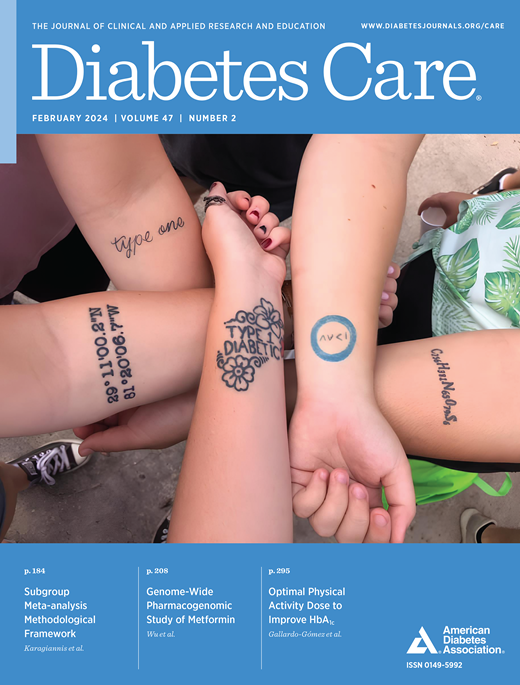使用生物标志物检测高血糖与连续血糖监测
IF 16.6
1区 医学
Q1 ENDOCRINOLOGY & METABOLISM
引用次数: 0
摘要
目的评价不同类型成人2型糖尿病患者中糖化白蛋白、果糖胺、1,5-无氢葡萄糖醇(1,5- ag)和血红蛋白A1c与连续血糖监测(CGM)指标的一致性。研究设计和方法对552名30 - 97岁糖尿病患者进行了汇总横断面分析。参与者使用CGM长达2周,我们评估了血液生物标志物(糖化白蛋白、果糖胺和1,5- ag)与CGM定义的高血糖和血糖控制指标之间的一致性。在552名参与者中(平均年龄74岁,53%女性,36%黑人),平均CGM葡萄糖的中位数为132 mg/dL,参与者平均84%的时间在70-180 mg/dL范围内。CGM平均葡萄糖与糖化血红蛋白(r = 0.72)、糖化白蛋白(r = 0.64)和果糖胺(r = 0.64)密切相关,但与1,5- ag (r = 0.46)相关性较弱。在180 mg/dL以上的时间范围内,结果相似。糖化白蛋白和果糖胺在目标时间范围内及以上的检测效果与HbA1c相似(c-统计量范围为0.85 ~ 0.94)。结论:与HbA1c相比,糖化白蛋白和果糖胺与cgm定义的高血糖指标具有相似的相关性。这三种生物标志物在时间范围以上和范围内的检测效果相似。我们的结果为糖化白蛋白和果糖胺作为高血糖的替代措施提供了证据。本文章由计算机程序翻译,如有差异,请以英文原文为准。
Detecting Hyperglycemia Using Biomarkers Versus Continuous Glucose Monitoring
OBJECTIVE To evaluate the concordance of glycated albumin, fructosamine, 1,5-anhydroglucitol (1,5-AG), and hemoglobin A1c (HbA1c) with continuous glucose monitor (CGM) metrics of hyperglycemia and glycemic control in a diverse population of adults with type 2 diabetes. RESEARCH DESIGN AND METHODS This was a pooled cross-sectional analysis of 552 adults, ages 30 to 97 years old, with diabetes. Participants wore a CGM for up to 2 weeks, and we evaluated the agreement between blood biomarkers (glycated albumin, fructosamine, and 1,5-AG) with CGM-defined metrics of hyperglycemia and glycemic control. RESULTS Of the 552 participants (mean age 74 years, 53% women, 36% Black), the median of mean CGM glucose was 132 mg/dL, and participants spent on average 84% of their time in range (70–180 mg/dL). CGM mean glucose was strongly related to HbA1c (r = 0.72), glycated albumin (r = 0.64), and fructosamine (r = 0.64) but weakly related to 1,5-AG (r = 0.46). Results were similar for time above range (>180 mg/dL). Glycated albumin and fructosamine performed similarly to HbA1c in the detection of target time in and above range (c-statistics ranged from 0.85 to 0.94). CONCLUSIONS Glycated albumin and fructosamine had similar associations with CGM-defined metrics of hyperglycemia compared with HbA1c. These three biomarkers performed similarly in the detection of time above range and in range. Our results provide evidence for the utility of glycated albumin and fructosamine as alternate measures of hyperglycemia.
求助全文
通过发布文献求助,成功后即可免费获取论文全文。
去求助
来源期刊

Diabetes Care
医学-内分泌学与代谢
CiteScore
27.80
自引率
4.90%
发文量
449
审稿时长
1 months
期刊介绍:
The journal's overarching mission can be captured by the simple word "Care," reflecting its commitment to enhancing patient well-being. Diabetes Care aims to support better patient care by addressing the comprehensive needs of healthcare professionals dedicated to managing diabetes.
Diabetes Care serves as a valuable resource for healthcare practitioners, aiming to advance knowledge, foster research, and improve diabetes management. The journal publishes original research across various categories, including Clinical Care, Education, Nutrition, Psychosocial Research, Epidemiology, Health Services Research, Emerging Treatments and Technologies, Pathophysiology, Complications, and Cardiovascular and Metabolic Risk. Additionally, Diabetes Care features ADA statements, consensus reports, review articles, letters to the editor, and health/medical news, appealing to a diverse audience of physicians, researchers, psychologists, educators, and other healthcare professionals.
 求助内容:
求助内容: 应助结果提醒方式:
应助结果提醒方式:


